Arizona Wild Flowers
Pictures, Photos, Images
Descriptions, Information, Reviews.
Longleaf Jointfir, Ephedra trifurca.
We Are Proud Of Our SafeSurf Rating!
Click On Any Of The Following Links By Amazon.Com
For Books, & Videos About Wildflowers Of Arizona & The Southwest USA. No Obligation!
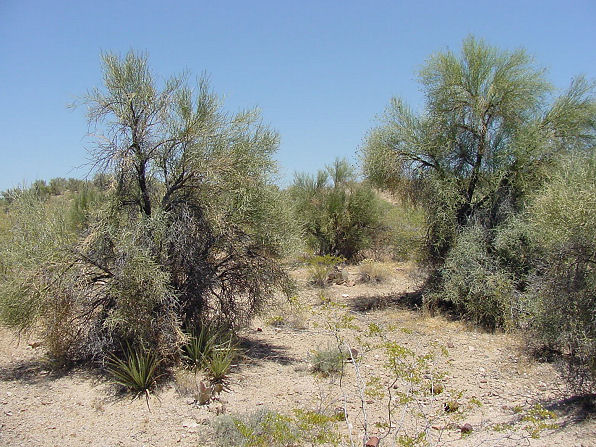 |
| Longleaf Jointfir, Ephedra trifurca. Photo Taken June 13, 2003. Near Hillside, Arizona. |
|---|
| Longleaf Jointfir, Ephedra trifurca. Photo Taken October 11, 2006. Boyce Thompson Arboretum, Near Superior, Arizona. |
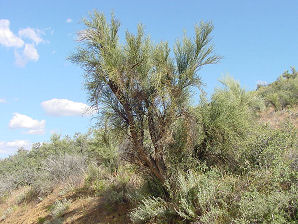 | 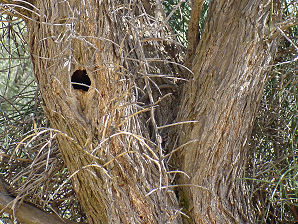 |
| 15 Foot Tall. Longleaf Jointfir. Ephedra trifurca. On A hillside. | Woodpecker Hole In Branch Off Of Thick Trunk Longleaf Jointfir. Ephedra trifurca. |
|---|---|
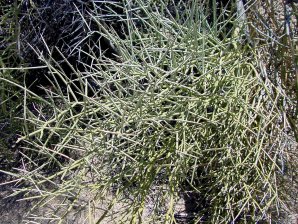 | 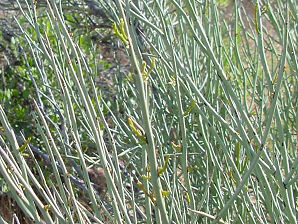 |
| Longleaf Jointfir. Ephedra trifurca. | Longleaf Jointfir. Ephedra trifurca. |
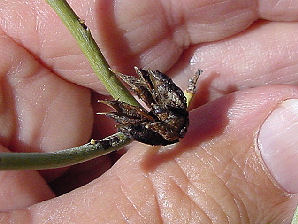 | |
| Longleaf Jointfir. Ephedra trifurca. | Longleaf Jointfir. Ephedra trifurca. |
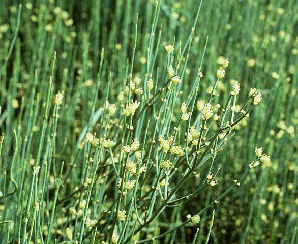 | |
| Male Cones. Longleaf Jointfir. Ephedra trifurca. | Female Cones. Longleaf Jointfir. Ephedra trifurca. |
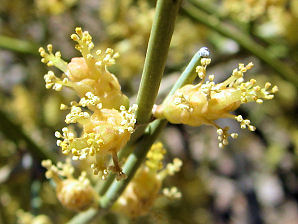 | 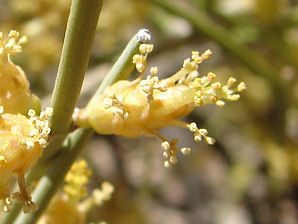 |
| "Flowers." Longleaf Jointfir. Ephedra trifurca. | "Flowers." Longleaf Jointfir. Ephedra trifurca. |
 /
/

Longleaf Jointfir.
We wish to thank Wikipedia, the free encyclopedia for some of the information on this page. We share images and information with Wikipedia. Longleaf Jointfir or Mexican Tea, is a gymnosperm, the group of non flowering plants that includes pines and junipers. Ephedras are dioecious, with male and female cones occurring on separate plants. The cones are borne singly or in pairs or whorls at the branch nodes. They are characterized by their greatly reduced, bractlike leaves and their evergreen, broomlike photosynthetic stems. The column-like, bright green leaves are jointed and orient themselves vertically. The arrangement somewhat resembles an inverted broom. The leaves are reduced to scales and grow in opposite pairs or whorls of three and are fused for half their length. Male and female flowers, blooming in March and April, are borne on separate plants in cone-like structures. They are followed by small brown to black seeds. The Male plant has male cones in spikelike clusters. The yellow structures that can be seen are the pollen producing microsporangia. The female plant has female cones 1-3 per cone, with 2-4 pairs of bracts. The small brown to black seeds are borne singly or in pairs in the axils of the female cone scales. The inner cone scales are modified to enclose the seed and form integuments that mimic the angiosperm pericarp. Flowering usually takes place in March through May, and seeds ripen from June through September, depending on elevation and species. The plants are wind-pollinated. Ephedra plants do not flower every year These woody shrubs grow 2 to 15 feet tall and up to about 10 feet wide. The terminal stems are thin, green, and essentially leafless. These are conifers more primitive than pine trees; they bear papery cones. The various species are similar in general appearance; distinguishing among them requires close inspection. About 40 species of Ephedra occur in other arid habitats of the world. Eight species occur in the Sonoran Desert region of Arizona. The distribution of male and female ephedra plants is not random; individuals on dry slopes are overrepresented by males, whereas those growing on run-on surfaces are 4 times as likely to be females as males (Freeman and others 1976). Thus, the Males, whose pollen is dispersed by wind, occur on steeper, drier spots, where wind prevails. Females, which require more moisture and nutrients for seed production, occur on wetter sites. The stems of the Old World species contain caffeine and ephedrine (a drug that acts like adrenalin/epinephrin). The closely related pseudoephedrine is now synthesized commercially and is an ingredient in commercial asthma and cold remedies, such as, Sudafed�. Pseudoephedrine is also used in the production of the dangerous illegal drug methamphetamine (�speed�). A tea with stimulant properties is made by steeping dried stems. It has been used medicinally to treat a variety of ailments including syphilis, diabetes, and pneumonia. Longleaf Jointfir ( Ephedra trifurca ) is often mistaken for Mormon Tea ( Ephedra viridis ). Thus, Ephedra trifurca is often mistakenly called, Mormon Tea, or Brigham Tea. These are names associated with Ephedra viridis. The Ephedra plant twigs, especially those of green Mormon Tea, are used to make a reputedly refreshing tea. The harmless substance pseudoephedrine is in Mormon Tea (Ephedra viridis), but the harmful substance ephedrine, found in the Old World species E. sinica Stapf., has not been detected in Mormon Tea ( Ephedra viridis ).
Quick Notes:
Height: 5 to 8 feet tall average, some up to about 12 - 15 feet.
Trunk: Up To About 2 1/2 Foot Thick. A single trunk sometimes with a few branches. Each branch can be 8 inches - 10 inches in diameter.
Stems: Stems green to yellowish-green, divided into different joint segments.
Flowers: This is a gymnosperm plant so it does not have flowers but cones that become very brittle and brown when dry.Tiny, pale yellow - male flowers on separate plants from females (dioecious). The ovulate spikes are distinctly stalked and the seeds are usually paired.
Flowering Time: March - April.
Leaves: When present are scalelike. Leaf scales are in twos, 1/16 inch long, sheathing to about the middle, and obtuse to acute at the apex.
Found: The USDA claims Ephedra trifurca is native to the USA (AZ, CA, NM, TX). In Arizona Ephedra trifurca is native to all counties except Coconino, Navajo, Apache, & Pinal. Ephedra trifurca is native to northern Mexico in Baja Norte, Chihuahua, Coahuila, & Sonora.
Hardiness:
Soil pH requirements:
Sun Exposure:
Elevation: Naturally found at 0 to 6,890 feet. Usually under 5,000 feet.
Habitat: Dry hillsides, flats and slopes in all the creosote bush deserts. Also found in higher elevation grasslands.
Miscellaneous: Photos Taken June 13, 2003. Near Hillside, Arizona. Others Taken April 25, 2005. An ideal xeriscape landscape plant in Arizona.
|



We Are Proud Of Our SafeSurf Rating!
Click On Any Of The Following Links By Amazon.Com
For Books, & Videos About Xerioscape Plants Of Arizona & The Southwest USA. No Obligation!
Click On Any Of The Following Links By Amazon.Com
For Books, & Videos About Wildlife Of Arizona & The Southwest USA. No Obligation!
Click On Any Of The Following Links By Amazon.Com
For Books, & Videos About Wildlife Of Arizona & The Southwest USA. No Obligation!
| © 1966 - Present, Audrey, Eve, & George DeLange |

